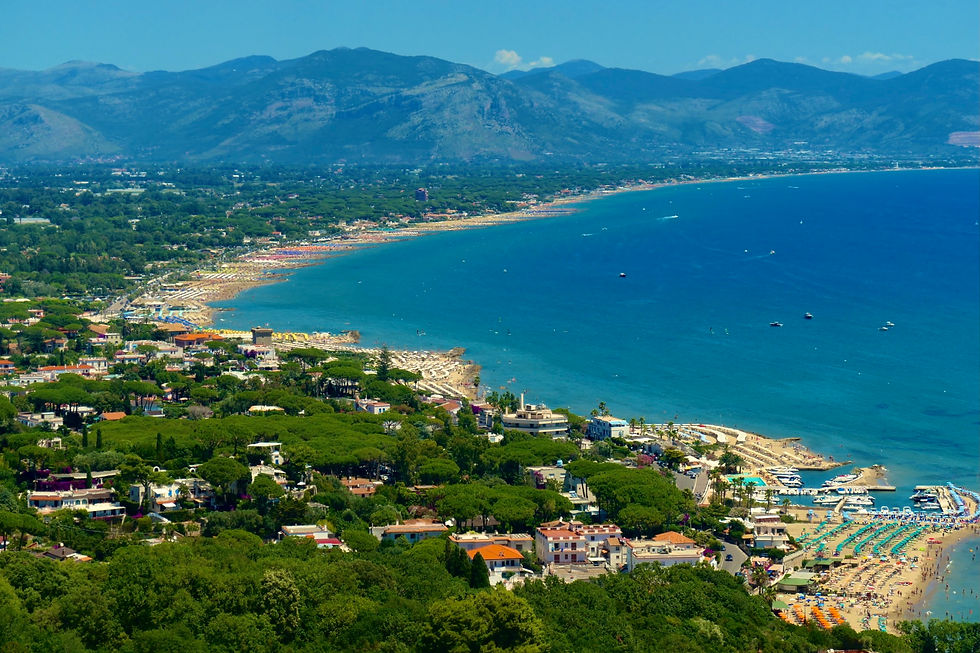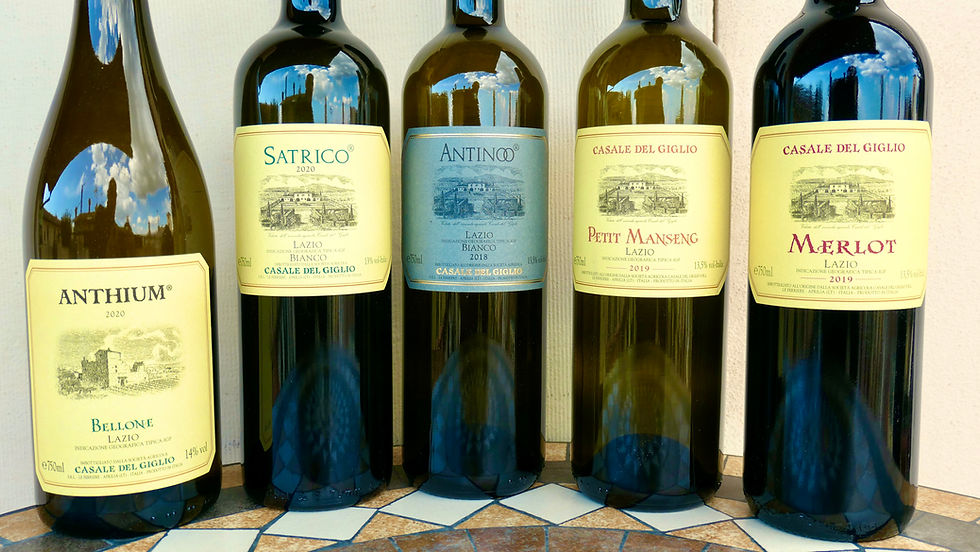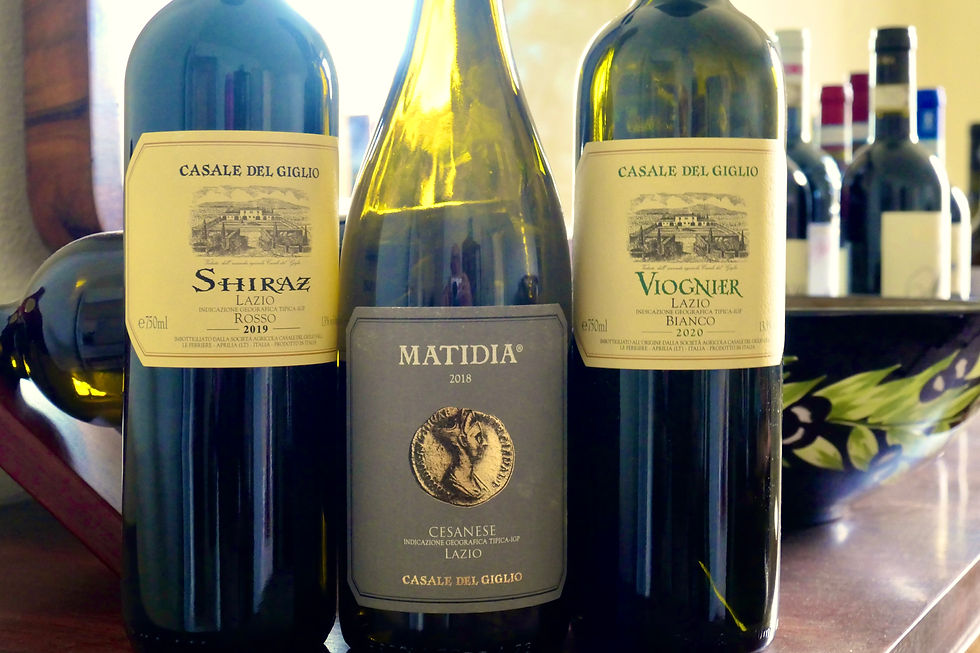Casale del Giglio, Lazio
- Mike
- Jul 11, 2021
- 6 min read
Updated: Dec 12, 2024
Many wine estates in Italy have centuries of production history but Casale del Giglio, Lazio dates back only to 1985 when the Santarelli family launched an ambitious research project on their extensive acreage in the Agro Pontino valley, 30 miles south of Rome and just inland from Anzio.

Known as the Pontine Marshes in English, this area was famously drained by Mussolini in the early 1930s in the most significant land reclamation project of the fascist era and brand new towns constructed on a 300 square mile area. At its center the town of Latina retains its fascist era architecture and in this area at least, peasants were given housing and some measure of land reform by Mussolini, something that was promised to Italians in the south for generations but rarely fulfilled.
The continuous four months of fighting around Anzio in 1944 destroyed just about the whole network of canals and pumps and had to be extensively repaired after the war. Malaria was finally eradicated in the early 1950s and today the land only stays reclaimed by continued pumping and water management.

It’s now a fertile and productive agricultural area and in 1985 Casale del Giglio planted almost 60 different experimental vines based on thorough research conducted by a diverse group of experts. They first studied similar maritime climate areas in Bordeaux, California and Australia and then began the slow process of planting vines and making wine to see which varieties worked best; over the last 35 years they have continued to refine the varietals and blends to concentrate on those showing the most promise. They now produce 20 different wines, evenly split between reds and whites with one rosato and all but one of their wines are priced very reasonably.
Not all of Casale del Giglio's vines are cultivated in their main location of the Agro Pontino because they are also one of the driving forces behind the rejuvenation of ancient wine growing areas in Olevano Romano and Anzio.
This area of Lazio is not the most scenic area to visit, lacking the history and charm as well as the topography of Chianti or the Valpolicella hills north of Verona, but the purpose of this article is to describe the wines of Casale del Giglio rather than recommend wine tourism here. However, just a few miles south along the coastline, the scenery changes very quickly and there are some fascinating and worthwhile places to visit like Gaeta, Terracina, Sabaudia and San Felice Circeo.
Sperlonga is also on this coastline but we found it to be one of those tiny places that are in danger of being completely ruined by over tourism so, despite what the guidebooks might say, it's not a favorite of ours and we prefer the other towns we mentioned.
We took the photograph below from half way up Monte Circeo looking south towards the Aurunci mountains with Terracina in the distance.

The Santarelli family was originally from Amatrice and they proudly include their traditional recipe for all’amatriciana on their website and it confirms everything we said about this famous dish.
Tasting Notes:
Satrico 2020 - Lazio IGT
(fermentation and aging in stainless steel, 13.5% alcohol)
Named after the ancient pre-Roman city of Satricum, next to which these vineyards are located and where there is an ongoing important archeological project, this is a blend of 40% Chardonnay, 40% Sauvignon Blanc and 20% Trebbiano Giallo.
All 3 grapes are vinified separately to preserve their distinctive aromas and then blended afterwards. The Sauvignon here really comes through on the fragrant nose together with hints of gooseberry. It’s a slightly tart mouth-watering wine that’s easy to drink but has some personality also. This blend actually works very well and at under 7 euros in Italy this is another of those fantastic white wine bargains from Lazio that you can pluck out of your wine fridge at short notice with the confidence that it will always be a reliable well made wine.
Petit Manseng 2019 - Lazio IGT (100% Petit Manseng)
(fermentation and aging in stainless steel, 13.5% alcohol)
A native grape of the Jurançon area of France in the Pyrenees foothills, this aromatic grape is more evidence of Casale del Giglio’s thoughtful experimentation in this entirely new wine area. The first pour into the glass releases white flowers, acacia and notes of white fruits, especially pear. Also slightly exotic hints of lychees. It’s a very aromatic wine but in the mouth extremely fresh with very good acidity thanks to it being racked and cooled immediately at the end of fermentation to prevent any spontaneous malolactic conversion taking place.
This is an interesting and impressive wine with structure and sapidity and a step up from the Satrico. At exactly 10 euros it’s very good value for a quality wine.

Antinoo 2018 - Lazio IGT
(fermentation in steel and aging in large tonneaux of acacia and oak, 13.5% alcohol)
This is a blend of 33% Chardonnay and 67% Viognier. Straw yellow with attractive floral notes. Very soft and round in the mouth and lacking a little acidity for me because of the malolactic conversion. Some vanilla present from the wood perhaps. This is a very easy wine to drink, well made and a good blend of grapes for this zone and it’s certainly pleasant enough but at 12 euros there are better bargains to be had in the Casale del Giglio range and in Lazio white wines generally.
Anthium 2019 - Lazio IGT (100% Bellone)
(fermentation and aging for 6 months in stainless steel, 14% alcohol)
One of Casale del Giglio's more well known wines, this is made from 60 year old vines in the sandy soils close to Anzio. This is an area like very few others in Italy (also Campi Flegrei in the Bay of Naples) where the sandy soils impeded the phylloxera pest over 100 years ago so ungrafted vines can still be cultivated.
Some tropical notes on the nose but also wet stones and iodine which show themselves in the mouth with mineral notes. Surprisingly rich and thick with good acidity and a dry slightly tangy finish. A lovely wine from a grape that does very well elsewhere in Lazio and another fabulous bargain at under 10 Euros in Italy.
Merlot 2019 - Lazio IGT (100% Merlot)
(fermentation in steel and aging for 12 months in oak barriques, 13.5% alcohol)
This wine has a slightly burnt reductive nose with hints of licorice, not what we were expecting from the Merlot grape. Definitely indicative of a hot climate Merlot. This characteristic follows through in the flavor of stewed fruits. I would like the wine more if I didn’t know it was Merlot but it’s not an unpleasant wine and considering it's priced under 7 euros it’s decent value. But it is made in a style that has its detractors and won’t suit everyone, despite the low price.

Viognier 2020 - Lazio IGT (100% Viognier)
(fermentation and aging on the lees in stainless steel, temperatures kept low to prevent malolactic conversion, 13.5% alcohol)
This is an immediately appealing wine with a lovely scent of crushed white flowers, peach and grapefruit. Viognier is a distinctive pleasantly aromatic grape variety and this wine is true to type. This is very fresh with the perfect amount of acidity and carries it's 13.5% alcohol lightly. It's not a Chateau Grillet by any means but nor does it cost $400 and for me at least this is a much more subtle and drinkable style of Viognier than the often slightly heavy, oily style typical of many California versions.
A very good example of what can be done with good research, experimentation and hard work. Excellent value at under 10 euros and this will undoubtedly join our best value list when we get around to doing one.
Matidia 2018 - Lazio IGT (100% Cesanese)
(aged partly in stainless steel and partly in oak tonneaux, 14% alcohol)
The grapes for this wine are grown on a 30 year old vineyard in the Olevano Romano area where the soil is volcanic limestone. Big nose of cherries is immediate apparent with muted notes of spices. Nice flavors and rounded tannins but hasn't fully knit together yet we don't think. Perhaps needs more time. Decent value at 11.50 euros but I'd rather spend a couple of euros more and buy either the 'Hernicus' or 'Silene', whose tasting notes appear here.
Shiraz 2019 - Lazio IGT (100% Syrah)
(fermented in stainless steel and aged in barriques for 8-12 months, 13.5% alcohol)
Deep ruby red with lots of black fruits on the nose and some pepper. This is a vibrant delicious Syrah but much more subtle than the in-your-face California syrahs that I recall from years ago. Soft tannins and very well balanced with a pleasant lingering finish. The bottle went very quickly so we both clearly enjoyed it and at 9 euros this represents tremendous value and will quickly find its way onto our personal list of great value Italian red wines.


